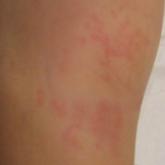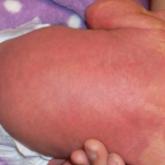Case Reports

Atypical Herpes Zoster Presentation in a Healthy Vaccinated Pediatric Patient
We report the case of a 6-year-old girl with no notable medical history who presented to the dermatology clinic for evaluation of left leg pain...
From the Department of Dermatology, Mt Sinai West of the Icahn School of Medicine, New York, New York.
The authors report no conflict of interest.
Correspondence: Nanette B. Silverberg, MD, Mt Sinai West, 425 W 59th St, Ste 8B, New York, NY 10019 (nanette.silverberg@mountsinai.org).

Periorificial dermatitis (POD) has been documented in the pediatric population in patients as young as 3 months, with a slight predominance in girls compared to boys. Many patients have a personal or family history of atopic disorders. Periorificial dermatitis typically presents with erythematous to flesh-colored papules and rarely pustules near the eyes, nose, and mouth. Although the etiology is unknown, many patients have had recent exposure to a topical or less commonly an inhaled or systemic corticosteroid. Although steroids may initially control the skin lesions, disease often rebounds after discontinuing therapy. Diagnosis of POD is clinical. Laboratory tests are not helpful in making the diagnosis, and the histology of POD resembles rosacea. It is important to rule out other acneform diagnoses based on the age of the patient, clinical history, and presentation of the lesions. Topical metronidazole has been successful in the pediatric population. For pediatric patients with extrafacial skin lesions or more severe disease, oral antibiotics such as tetracycline, doxycycline, minocycline, azithromycin, and erythromycin can be used, depending on the age of the patient.
Practice Points
Perioral dermatitis is an acneform eruption presenting with erythematous papules, vesicles, and rarely pustules clustered around the orifices of the face. 1 Lesions may be found near the eyes, mouth, and nose but typically spare the vermilion border of the lips. 2 Nguyen and Eichenfield 3 preferred the term periorificial dermatitis (POD), which has since been adopted by others. 4 Patients may report pruritus, but there generally are no systemic symptoms unless patients have comorbid conditions such as atopic dermatitis. 5 Although this condition has been well examined in the literature on adults, data in the pediatric population are far more limited, consisting of case series and retrospective chart reviews. In 1979, Wilkinson et al 6 published a study of more than 200 patients with perioral dermatitis, but only 15 patients younger than 12 years were included.
Although the exact pathogenesis of POD is unknown, a common denominator among many patients is prior exposure to topical corticosteroids.3,7-9 Periorificial dermatitis also has been linked to the use of systemic corticosteroids in pediatric patients.10 The exact relationship between steroid use and dermatitis is unknown; it may be related to a change in the flora of hair follicles and in particular an association with fusiform bacteria–rich conditions.11 Aside from steroid exposure, POD has been associated with the use of physical sunscreen in pediatric patients with dry skin,12 rosin in chewing gum,13 and inhaled corticosteroids in those with asthma.14 In one case, a 15-year-old adolescent girl developed POD and swelling of the lips after 2 years of playing a flute made of cocus wood.15,16
In the largest chart review to date in the US pediatric population, Goel et al17 examined the clinical course of POD in 222 patients aged 3 months to 18 years at the Dermatology Clinic at the University of North Carolina Chapel Hill between June 2002 and March 2014. Consistent with prior studies, females seemed to be slightly more affected than males (55.4% vs 44.6%).17 Similarly, the patient population for a study conducted by Nguyen and Eichenfield3 consisted of more females (58% [46/79]) than males (42% [33/79]). Weston and Morelli9 conducted a retrospective chart review of steroid rosacea in 106 patients younger than 13 years, which included 29 patients younger than 3 years; the study included 46 males and 60 females.
Goel et al17 (N=222) reported the following comorbidities associated with pediatric POD: atopic dermatitis (29.3%), asthma (14.9%), and allergies (9.9%). Steroid exposure was noted in 58.1% of patients.17 Similarly, Nguyen and Eichenfield3 (N=79) found that the most common comorbidities were atopic dermatitis (14%), keratosis pilaris (14%), viral infections (14%), acne (10%), and seborrheic dermatitis (10%). Family history of atopy was noted in 55% of patients and family history of rosacea was noted in 3%. In a case series of 11 pediatric patients, 3 (27%) had keratosis pilaris, 7 (64%) had a family history of atopy, and 2 (18%) had a family history of rosacea.8 Weston and Morelli9 found a much higher incidence of familial rosacea (20%) in 106 children with steroid rosacea. It is hard to interpret the role of genetic tendency in rosacea, as different populations have different background prevalence of rosacea and atopic dermatitis (ie, rosacea is immensely more common in white individuals).
Periorificial dermatitis generally presents with small, pink- to flesh-colored papules in a perioral, periocular, and perinasal distribution. Although many patients are white, a particularly prominent variant has been noted in black children with papules that may be hyperpigmented.18 In a 2006 chart review in 79 pediatric POD patients aged 6 months to 18 years, Nguyen and Eichenfield3 reported that 92% (73/79) of patients presented for a facial rash with an average duration ranging from 2 weeks to 4 years. Interestingly, although Tempark and Shwayder1 did not report burning associated with pediatric POD, Nguyen and Eichenfield3 found that 19% of patients reported pruritus and 4% reported burning or tenderness. Seventy-two percent of patients had been exposed to steroids for treatment of their dermatitis. Seventy percent had perioral involvement, 43% had perinasal involvement, 25% had periocular involvement, and 1% had a perivulvar rash; 64% of patients only had perioral, perinasal, and periocular involvement. In others, lesions also were found on the cheeks, chin, neck, and forehead. Perioral lesions were more likely to be found in patients younger than 5 years compared to those who were at least 5 years of age. Eighty-six percent of patients had erythema with or without scaling, 66% had papules, and 11% had pustules. Fewer than 3% had lichenification, telangiectases, or changes in pigmentation.3
Boeck et al19 described 7 pediatric patients with perioral dermatitis. Six (86%) patients had perioral lesions, and 6 (86%) had previously been treated with moderate- to high-potency topical corticosteroids. Skin prick tests were negative in 6 (86%) patients.19 In one case report, a 6-year-old boy did not present with the classic acneform lesions but rather sharply demarcated eczematous patches around the eyes, nose, and mouth. The rash began to fade after 2 weeks of using metronidazole gel 1%, and after 4 months he was only left with mild hyperpigmentation.4
Periorificial dermatitis was once thought to be a juvenile form of rosacea.5 In 1972, Savin et al8 described 11 pediatric patients with “rosacea-like” facial flushing, papules, pustules, and scaling over the cheeks, forehead, and chin. In some patients, the eyelids also were involved. At least 8 patients had been using potent topical corticosteroids and had noticed exacerbation of their skin lesions after stopping therapy.8
Several other variants of POD have been described in pediatric patients including childhood granulomatous periorificial dermatitis (CGPD)(also known as facial Afro-Caribbean [childhood] eruption) and lupus miliaris disseminatus faciei. Childhood granulomatous periorificial dermatitis presents in prepubertal children as dome-shaped, red to yellow-brown, monomorphous papules around the eyes, nose, and mouth; there are no systemic findings.20,21 It occurs equally in males and females and is more commonly seen in dark-skinned patients. Childhood granulomatous periorificial dermatitis usually resolves within a few months to years but may be associated with blepharitis or conjunctivitis.20 Urbatsch et al20 analyzed extrafacial lesions in 8 patients (aged 2–12 years) with CGPD. Lesions were found on the trunk (38% [3/8]), neck (25% [2/8]), ears (25% [2/8]), extremities (50% [4/8]), labia majora (38% [3/8]), and abdomen (13% [1/8]). In addition, 2 (25% [2/8]) patients had blepharitis.20
Lupus miliaris disseminatus faciei, which occurs in adolescents and adults, commonly involves the eyelids and central areas of the face such as the nose and upper lips. Patients typically present with erythematous or flesh-colored papules.1
Diagnosis of POD is made clinically based on the observation of papules (and sometimes pustules) around the orifices of the face, sparing the vermilion border, together with a lack of comedones.17 Laboratory tests are not useful.5 Biopsies rarely are performed, and the results mimic those of rosacea, demonstrating a perifollicular lymphohistiocytic infiltrate, epithelioid cells, and occasionally giant cells.5,22,23 Early papular lesions can show mild acanthosis, epidermal edema, and parakeratosis.23 Biopsies in patients with CGPD reveal noncaseating perifollicular granulomas.20

We report the case of a 6-year-old girl with no notable medical history who presented to the dermatology clinic for evaluation of left leg pain...

We present a unique case of 3 vascular malformations—Sturge-Weber syndrome (SWS), facial infantile hemangioma (IH), and cutis marmorata...

This article exhibits the most common presentations of vesiculobullous diseases in newborns and reviews the clinical characteristics unique to...
